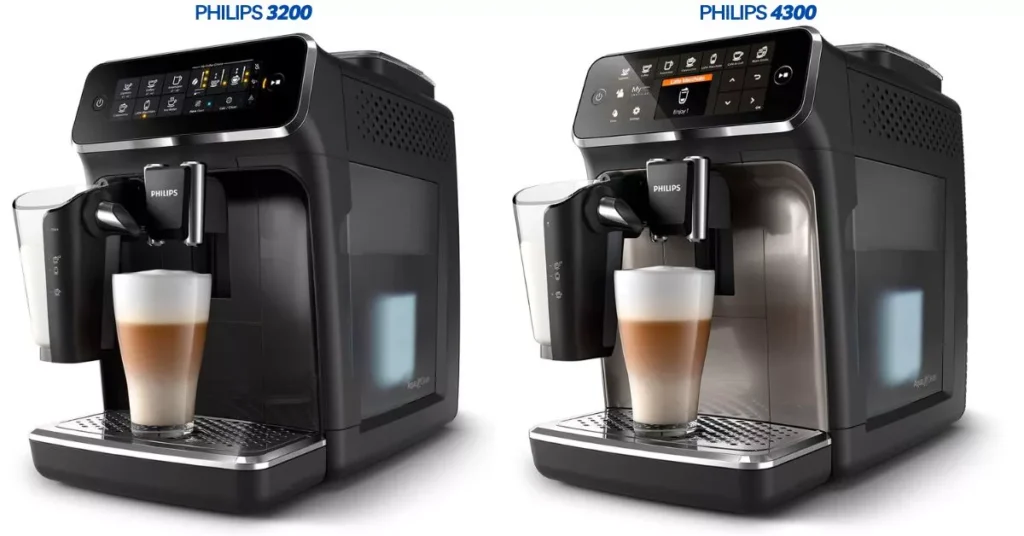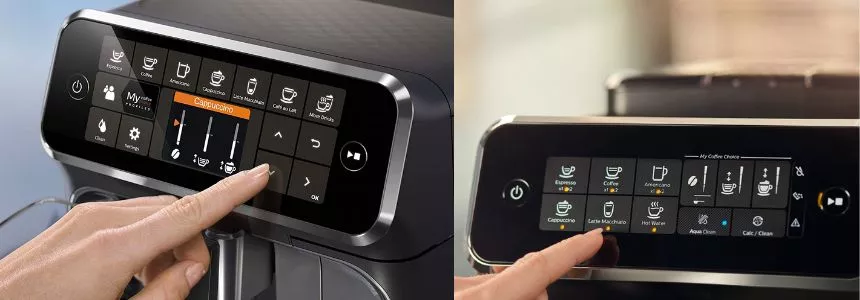The main difference between the Philips 4300 and the Philips 3200 is that the 4300 has a button-operated digital display screen control panel whereas the 3200 doesn’t.
The choice between the Philips 4300 vs. 3200 hinges on whether you think it’s worth paying an extra ~$150 for a display screen user interface.
I’m going to explain how the Philips 4300’s display screen user interface affects the machine’s usability so you can decide whether you should pay this premium for it.
Please note that when I compare these two units, I’m talking strictly about the models with the LatteGo milk frother rather than the steam wand.
Let’s get started.
Should I Buy the Philips 4300 LatteGo or Philips 3200 LatteGo?
I would recommend the Philips 3200 LatteGo to the Philips 4300 LatteGo to most people.
While the Philips 4300 LatteGo’s display screen user interface makes the machine slightly easier to use, I don’t think it’s worth paying extra just to have this.
The two machines produce the exact same quality of coffee and steamed milk.
They also have a similar build quality. So I think you get better value with the Philips 3200 vs. 4300.
The main benefit of the Philips 4300’s superior user interface is that it’s easier to start up and troubleshoot when something goes wrong.
I’d therefore recommend it for offices where you don’t want your staff wasting time troubleshooting an espresso machine or if you or the person you are buying for struggles with using tech generally.

What are the Differences Between the Philips 4300 and Philips 3200?
The differences between the Philips 4300 and 3200 are:
- The Philips 4300 has a digital display screen user interface whereas the Philips 3200 does not.
- The Philips 4300 has nine available drinks to the 3200’s five.
- The Philips 4300 offers you five coffee strength and size customizations compared to the 3200’s three.
- The Philips 4300 has two user profiles. The 3200 has none.
- The Philips 4300 has a dedicated LatteGo cleaning mode, the Philips 3200 does not have this feature.
| Machine Name | Black Drink Options | Milk Drink Options | User interface | User Profiles | LatteGo cleaning mode |
| Philips 3200 LatteGo | 3 | 2 | Buttons only | None | No |
| Philips 4300 LatteGo | 5 | 3 | Button operated TFT screen | 2 | Yes |
User Interface
The Philips 4300’s touchscreen user interface makes the machine far easier to troubleshoot than the 3200s. Their day-to-day ease of use isn’t actually that different.

The Philips 4300’s display screen walks you through every step of using the machine, from setting it up to making a drink to its cleaning process.
Everything is explained in plain English – it couldn’t be simpler.
The Philips 3200 is still incredibly simple to use even though it doesn’t have this display screen.
All its buttons are labeled with an image of the drink it corresponds to and its name, leaving you in no doubt of what you’re selecting.
The only buttons that are a bit vague are the warning buttons. You can see these below:
The generic warning label is particularly annoying as this can mean one of three things:
- A blocked brew group
- A blocked grinder
- A missing or out-of-position brew group
The Philips 4300 will just tell you on its screen exactly what this problem is, making troubleshooting much easier.
Drink Options
The Philips 4300 LatteGo has four more drink options than the Philips 3200 LatteGo. A lot of the 4300’s extra drinks are superfluous, however.
The table below shows the drinks that each machine has on their menu:
| Machine Name | Black Drink Options | Milk Drink Options | User interface | User Profiles | LatteGo cleaning mode |
| Philips 3200 LatteGo | 3 | 2 | Buttons only | None | No |
| Philips 4300 LatteGo | 5 | 3 | Button operated TFT screen | 2 | Yes |
Both machines can also dispense plain hot water.
Philips’ 4300 LatteGo’s “other drinks” menu
Although the 4300’s four extra drinks seem like a lot, a lot of their additional drinks are pretty redundant. For example:
- Cafe crema is very similar to Americano. Whereas the Americano is an espresso followed by a shot of water, the cafe crema is just an espresso brewed with a little bit of extra water. They taste almost identical.
- Ristretto is just a smaller espresso. You can recreate this on the Philips 3200 LatteGo by brewing an espresso on its minimum size setting.
Drink Customizations
The Philips 4300 offers you five strength sizes and milk volume settings per drink. The 3200 only offers you three settings.
The two model’s maximum and minimum strength/sizes are the same, so the only difference is in granularity between each set.
While the Philips 4300 LatteGo does give you a bit more control over how you brew compared to the 3200, these differences are, again, marginal.
You can also stop brewing manually on both machines if you want to brew a drink to a specific size.
Both machines allow you to brew doubles of each of their black coffee drinks. This is not a feature exclusive to the Philips 4300.
User Profiles
The Philips 4300 has two user profiles to which you can save drink preferences. The Philips 3200 does not have this.
Whatever drink strength and size you brew can be saved as the new default on your user profile.
Again, I don’t think that this feature should be a deciding factor in which espresso machine you buy.
It’s so easy to change a drink’s strength and size on either machine that I don’t see having an extra user profile adding that much value. It will save you one or two button presses per drink at most.
LatteGo Cleaning Mode
Only the Philips 4300 LatteGo has a dedicated LatteGo cleaning mode. The only problem is that it doesn’t work very well.
The LatteGo cleaning mode is accessed in the 4300’s settings menu and runs water through the LatteGo carafe’s milk spout.
It doesn’t really clean the carafe properly, you’ll still need to wash it by hand (or in the dishwasher) if you want to stop the milk system from crusting up with sour milk.
Needless to say, I don’t think it’s worth paying extra for this feature.
What Do the Philips 4300 LatteGo and Philips 3200 LatteGo Have in Common?
- Drink quality: Both machines use the exact same espresso brewing and milk steaming system so their drink quality is identical. They can both only steam your milk to one texture.
- Build quality: Both machines have relatively poor build quality and low level of durability by super-automatic espresso machine standards. That’s a big part of the reason why they are both on the cheaper end of the super-automatic spectrum.
- Grinder: Both machines use a flat ceramic burr grinder with 13 grind size settings. They both also have a bypass doser for pre-ground coffee.
- Cleaning Process: Both machines run automatic rinse cycles but need to have their drip tray and used coffee grounds container emptied and cleaned manually. You can put both their milk systems in the dishwasher.
- Descaling: Both machines use an AquaClean water filter meaning that they only need to be descaled every 5000 brews. The filter itself needs to be replaced every three months. Only the Philips 4300 will tell you when to replace its filter.
- Shape and size: Both machines measure up at 9.7″ W x 17.0″ D x 14.6″ H.
You can see a video on how to clean and maintain both machines below:
If you’d like to find out more about either of these machines you can check out my Philips 4300 LatteGo review or Philips 3200 LatteGo review where I cover each machine in depth.
Philips 4300 vs 3200: Final Verdict
I recommend the Philips 3200 LatteGo over the 4300 to most people as I don’t think the 4300 does enough to justify costing $150 more than the Philips 3200.
The Philips 4300 is a marginally better espresso machine than the 3200, so if cost doesn’t matter to you then go for the Philips 4300.
Source: https://nookcoffeebar.com/espresso-machines/philips/3200-vs-4300


